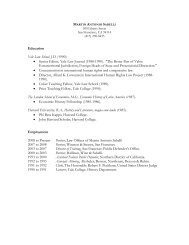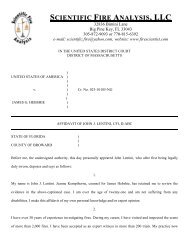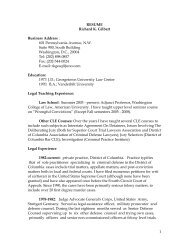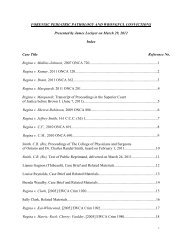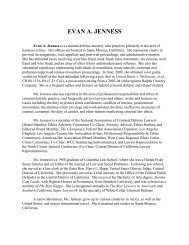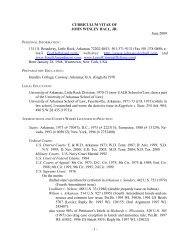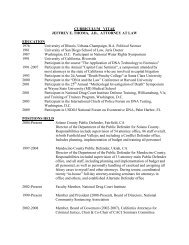A Biomechanical Analysis of the Causes of Traumatic ... - NACDL
A Biomechanical Analysis of the Causes of Traumatic ... - NACDL
A Biomechanical Analysis of the Causes of Traumatic ... - NACDL
You also want an ePaper? Increase the reach of your titles
YUMPU automatically turns print PDFs into web optimized ePapers that Google loves.
The American Journal <strong>of</strong> Forensic Medicine and Pathology • Volume 25, Number 2, June 2004TBI in Infants and Childrendetermined that contact duration is 3–7 milliseconds bydropping a weight-adjusted cadaver skull onto <strong>the</strong> edge <strong>of</strong> ahardwood stair step. If only <strong>the</strong> impact <strong>of</strong> <strong>the</strong> head produces<strong>the</strong> contact force (<strong>the</strong> weight <strong>of</strong> <strong>the</strong> body does not contribute),<strong>the</strong> contact time is taken as 5 milliseconds and <strong>the</strong> headweighs 22.4 Newtons (N) (5.3 lb), 20% <strong>of</strong> <strong>the</strong> body weight <strong>of</strong>112 N (26.4 lb), <strong>the</strong> peak force is 4070 N (915 lb) from <strong>the</strong>linear impulse-momentum relation, assuming a triangularforce pr<strong>of</strong>ile. This is a peak acceleration <strong>of</strong> 173 g, nearlysixteen times greater than would be obtained by shaking andtwice as great as <strong>the</strong> tolerance limit suggested by Stürtz. 39These linear acceleration values approach those obtainedfrom <strong>the</strong> previously described actual experiments; 45–47 <strong>the</strong>small differences are most likely due to variation in surfacecharacteristics or a conservative assumption for <strong>the</strong> contacttime in <strong>the</strong> above analysis.There has been sworn testimony in courts <strong>of</strong> law byexpert witnesses who state that trauma caused by shaking isequivalent to a fall from a two-story (or higher) window onto<strong>the</strong> pavement. 73 If such a fall is head first with <strong>the</strong> body in avertical or near vertical position at impact, <strong>the</strong> forces on <strong>the</strong>head can be calculated from <strong>the</strong> linear impulse-momentumlaw. Assuming that <strong>the</strong> weight <strong>of</strong> <strong>the</strong> child is 66.7 N (15 lb),that <strong>the</strong> fall height is 5.63 m (18 ft), and that <strong>the</strong> contactduration is a very conservative 10 milliseconds, <strong>the</strong> impactvelocity will be 10.37 m/s (34 ft/s), and <strong>the</strong> peak contact force14,190 N (3167 lb). This exceeds by at least an order <strong>of</strong>magnitude <strong>the</strong> force that can be exerted by shaking, and atleast 3 times that considered from <strong>the</strong> data <strong>of</strong> Gurdjian 30 as<strong>the</strong> human tolerance limit. The analogy <strong>of</strong> “shaking” injuryto that from a two-story fall is not justifiable.It has also been stated that falls from low heights do notproduce significant injury or death. 74–76 However, Mohan etal 77 analyzed 30 falls in children under <strong>the</strong> age <strong>of</strong> 10, andreconstructed 6 <strong>of</strong> <strong>the</strong>m using <strong>the</strong> MVMA Two-DimensionalCrash Victim Simulator computer model. The authors concludedthat falls as low as 2 meters may cause serious injuryor death.Plunkett documented 18 fatal falls from heights <strong>of</strong> 0.6to3m(2–10 ft). 24 One <strong>of</strong> <strong>the</strong>se falls was coincidentallyvideotaped, permitting an approximate analysis <strong>of</strong> <strong>the</strong> contactloads. A 23-month-old girl who weighed 129 N (29 lb) andwas 0.838 m (33 in) tall fell from a play structure onto a 10mm (0.39 in) thick carpet without foam backing covering aconcrete floor. She had lost her grip on a rail when she wasin a nearly horizontal position approximately 1.07 m (42 in)above <strong>the</strong> ground. She struck <strong>the</strong> ground first with heroutstretched hands and <strong>the</strong>n with her right upper frontalforehead, followed by her right shoulder (Fig. 9). Althoughalert immediately after <strong>the</strong> fall, she became unconsciouswithin approximately 5 minutes. She was taken to a tertiarycare hospital where a 100 mL right-sided SDH was immediatelyevacuated. The attending medical staff documentedFIGURE 9. Idealized contact position and loads in <strong>the</strong> fall <strong>of</strong> a29 lb (12.9K) child from a height <strong>of</strong> 42 in (1.07 m).extensive bilateral retinal hemorrhage (RH) following <strong>the</strong>surgery. Postoperatively, she developed refractory cerebraledema and was removed from life support after 1.5 days. Anautopsy showed a small residual right SDH, cerebral edemawith herniation, and a 40 45 mm (1.58 1.77 in) rightfrontal scalp contusion. There was no skull fracture.Her unsupported weight caused rotation about her feetuntil her body was at an angle <strong>of</strong> approximately 45° from <strong>the</strong>horizontal, with her head and neck inclined at approximately30° to <strong>the</strong> horizontal. Her feet <strong>the</strong>n disengaged <strong>the</strong> playstructure and she fell freely with her center <strong>of</strong> gravity dropping0.483 m (19 in) until she struck <strong>the</strong> carpet. If <strong>the</strong> moment<strong>of</strong> inertia (<strong>the</strong> property <strong>of</strong> an object to resist rotation) taken at<strong>the</strong> center <strong>of</strong> mass, G, is idealized as a uniform cylinder witha radius <strong>of</strong> 101.6 mm (4 in), her moment <strong>of</strong> inertia about herfeet is 3.116 N-m-s 2 (27.57 lb-in-s 2 ). 48 The impact velocitydue to rotation, using a number <strong>of</strong> simplifying assumptions, is4.36 m/s (14.3 ft/s) whose vertical component is 3.78 m/s(12.4 ft/s). The concurrent velocity due to <strong>the</strong> vertical motion<strong>of</strong> <strong>the</strong> center <strong>of</strong> gravity in <strong>the</strong> fall is 3.05 m/s (10 ft/s), so that<strong>the</strong> impact velocity <strong>of</strong> <strong>the</strong> head is 6.83 m/s (22.4 ft/s)(compared with 4.57 m/s 15 ft/s if <strong>the</strong> body remainedentirely horizontal). This calculation ignores <strong>the</strong> brakingeffect <strong>of</strong> <strong>the</strong> outstretched arms, so that <strong>the</strong> likely impact speed<strong>of</strong> <strong>the</strong> head was <strong>of</strong> <strong>the</strong> order <strong>of</strong> 4.57–6.10 m/s (15–20 ft/s).Since <strong>the</strong> skull, scalp and carpet were not available tomeasure compliance, <strong>the</strong> contact duration will be conservativelyassumed to be 10 milliseconds. The child’s weightdistribution will be assumed to be 107 N (24 lb) for torso,© 2004 Lippincott Williams & Wilkins 95





